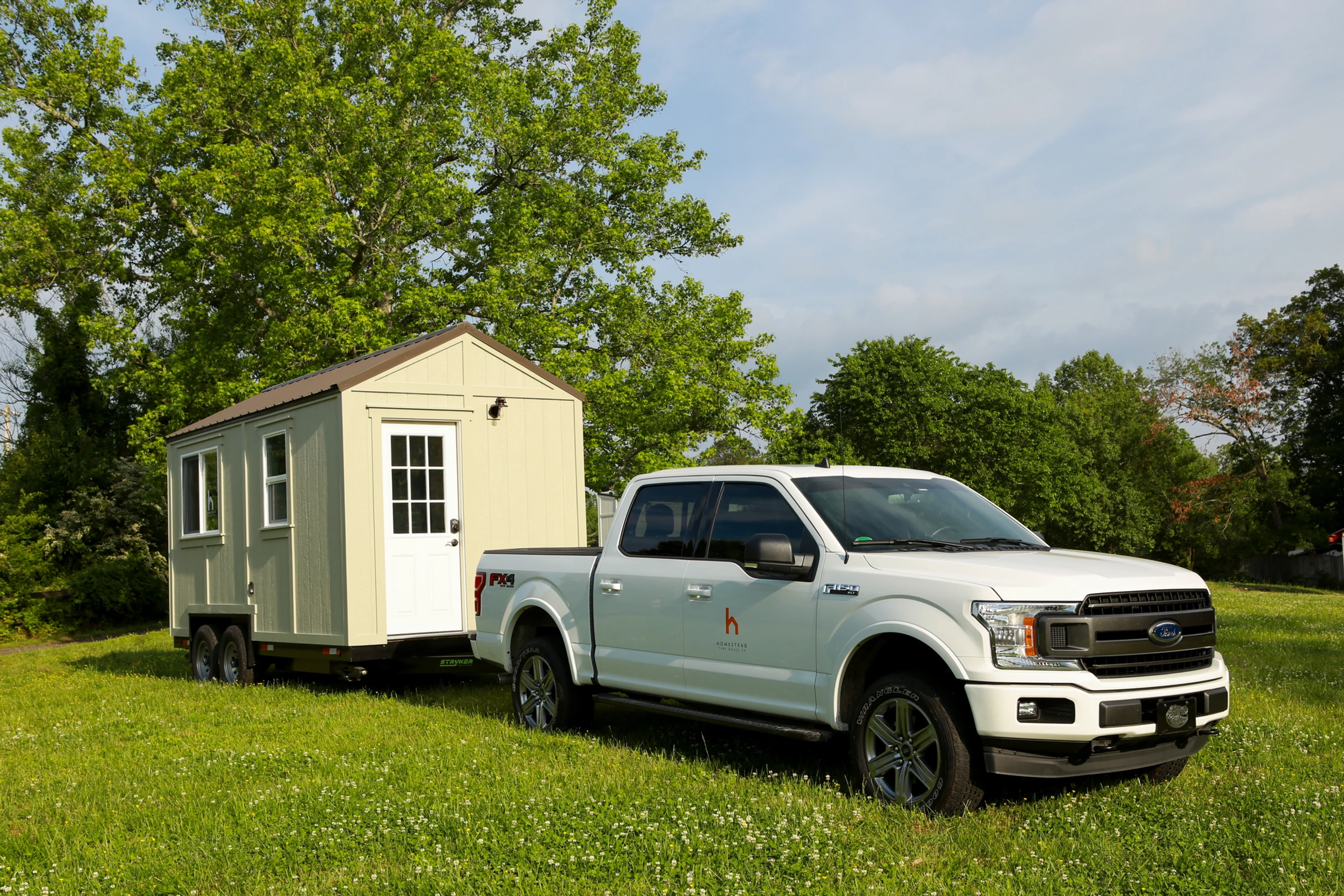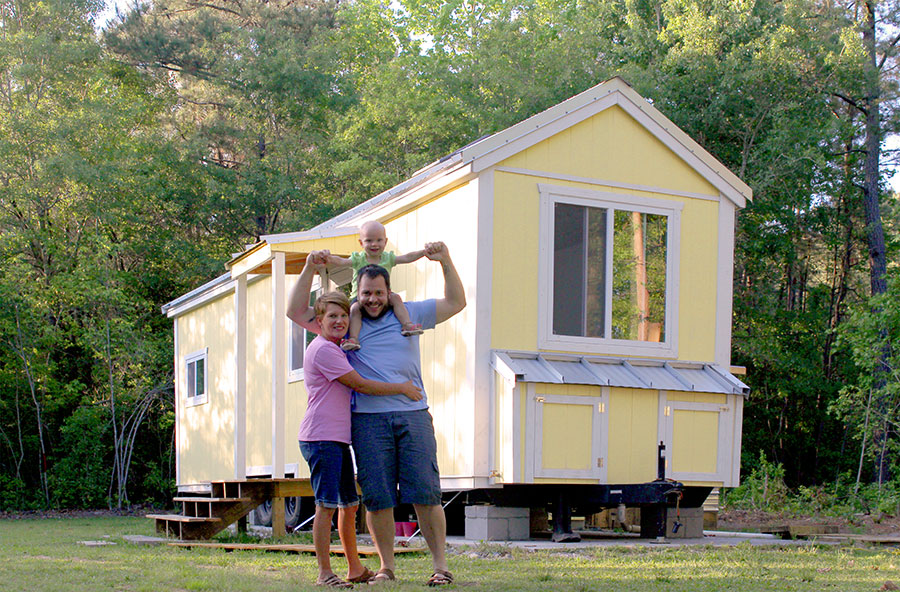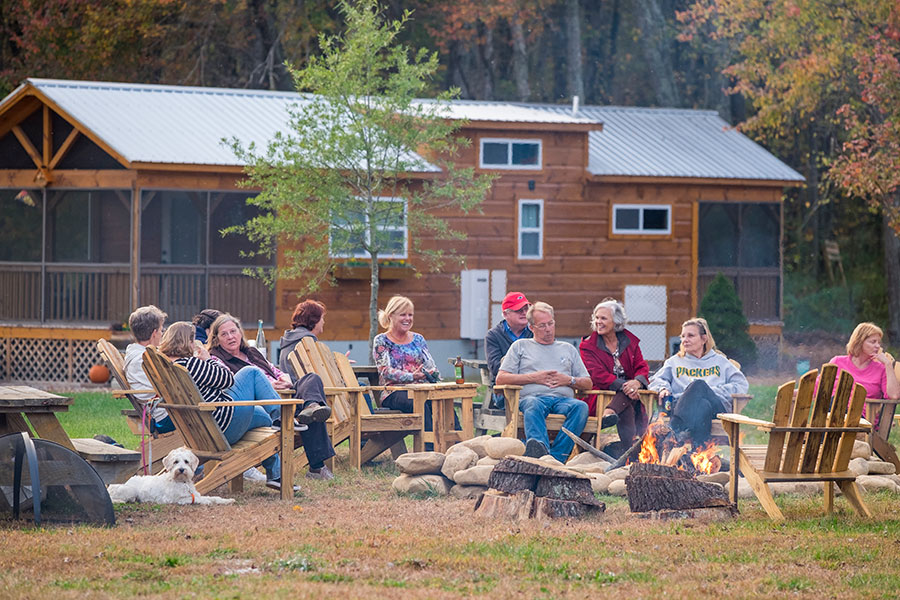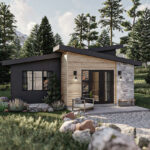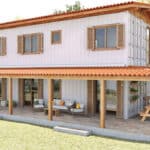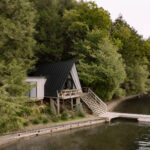The rise of tiny houses has revolutionized the way people live and travel. These compact and portable homes offer the freedom to explore new places without sacrificing the comforts of home. Whether you’re a digital nomad, a nature enthusiast, or simply seeking a minimalist lifestyle, a tiny house on wheels can be the perfect solution.
Choosing the right tiny house for travel is crucial to ensure a smooth and enjoyable experience on the road. When selecting a tiny house, consider its weight and size. It’s important to find a balance between a compact design that allows for easy maneuverability and spacious enough to accommodate your needs.
Another crucial aspect to consider is the mobility features and design of the tiny house. Look for features like a reinforced trailer frame, sturdy wheels, and a reliable towing hitch. These features will make it easier to transport your tiny house from one location to another.
Additionally, consider the off-grid capabilities of the tiny house. Look for features like solar panels, water storage tanks, and composting toilets. These features will allow you to live sustainably and independently, even in remote locations.
Before hitting the road, it’s essential to understand the legalities and regulations surrounding tiny house travel. Zoning and parking restrictions vary from place to place, so it’s crucial to research the laws in your destination. Some areas may have specific requirements for parking or may restrict the use of tiny houses altogether.
Researching local laws and regulations will help you determine where you can legally park your tiny house and what permits or licenses you may need. It’s important to comply with these regulations to avoid any legal issues during your travels.
Once you have chosen the right tiny house and familiarized yourself with the legalities, it’s time to prepare the essential supplies and equipment for your journey. In a tiny house, space is limited, so it’s crucial to choose kitchen essentials that are compact and multipurpose.
Invest in efficient storage solutions like collapsible containers, hanging organizers, and under-bed storage compartments. These will help you maximize the available space and keep your belongings organized.
Additionally, don’t forget to stock up on safety equipment and emergency supplies. Fire extinguishers, smoke detectors, first aid kits, and emergency contact information are crucial in ensuring your safety while on the road.
As with any form of travel, budgeting and financial considerations are important when living in a tiny house on wheels. Consider the costs of fuel and maintenance, as well as campground fees and parking expenses.
Living expenses may vary depending on your lifestyle and preferences. It’s important to create a budget and track your spending to ensure that you can sustain your travels comfortably.
When planning your travel routes, take time to research RV-friendly destinations. Look for campgrounds and RV parks that can accommodate tiny houses. Additionally, consider road conditions and access to ensure a smooth journey.
Map out rest areas and campgrounds along your route to plan for breaks and overnight stays. This will help you stay organized and avoid any last-minute challenges in finding suitable places to park your tiny house.
Maintenance and repairs are inevitable when traveling with a tiny house. Regular inspections and maintenance routines are essential to keep your tiny house in top shape.
Before hitting the road, conduct a thorough inspection of the exterior and interior of your tiny house. Check for any signs of wear and tear, leaks, or mechanical issues. Addressing these problems early on can save you from larger repair costs down the road.
In the event of a breakdown or malfunction, it’s crucial to have a list of reliable repair services along your route. Research local repair shops or mobile repair services that specialize in tiny houses or RVs. Having this information handy can save you time and stress in case of an emergency.
Staying connected on the road is important for both work and personal reasons. Research internet and communication options that suit your needs. Look for mobile hotspots or campground Wi-Fi availability to stay connected online.
Additionally, finding reliable sources of power is essential for sustaining your daily activities in a tiny house. Consider investing in solar panels or portable generators to ensure you have access to electricity, especially when camping off-grid.
Finally, safety and security should always be a priority when living in a tiny house on wheels. Take measures to secure your tiny house while traveling, such as installing sturdy locks and an alarm system.
Personal safety precautions, such as keeping emergency contact information handy and practicing safe driving habits, are also crucial. Additionally, consider obtaining insurance that covers your tiny house and belongings while on the road.
Living in a tiny house on wheels doesn’t mean you have to travel alone. Finding community and support can enhance your travel experience. Join online communities and forums dedicated to tiny house living and connect with fellow travelers. These platforms can provide valuable advice, tips, and even potential meetups and gatherings.
Lastly, embracing minimalism and sustainable living is a natural fit for life on wheels. Downsizing and decluttering your possessions will not only free up space in your tiny house but also simplify your life.
Practice sustainable habits like recycling, conserving water and energy, and using eco-friendly products. Embracing a minimalist lifestyle while traveling will not only reduce your environmental footprint but also allow you to focus on the experiences and adventures that lie ahead.
In conclusion, life on wheels in a tiny house offers the freedom and adventure that many people crave. By following these essential tips for tiny house travelers, you can make the most of your journey and create unforgettable memories along the way. So, pack your bags, hit the road, and embrace the joys of life on wheels!
The rise of tiny houses and the freedom of travel
Tiny houses have become a popular housing option in recent years, offering an affordable and sustainable alternative to traditional homes. These compact living spaces are designed to maximize functionality and minimize environmental impact. But what if you want to take your tiny house on the road and experience the freedom of travel? In this article, we will explore essential tips for tiny house travelers, from choosing the right house to navigating legalities and regulations, budgeting for your travels, planning your routes, ensuring maintenance and repairs, staying connected on the road, prioritizing safety and security, finding community and support, and embracing minimalism and sustainable living.
Choosing the Right Tiny House for Travel
When it comes to choosing a tiny house for travel, there are a few important factors to consider. First, you need to assess the weight and size of the house. It should be within the towing capacity of your vehicle if you plan to tow it yourself. Additionally, the size should be manageable for maneuvering on the road and fitting into various parking spaces.
Mobility features and design are also crucial aspects to look for in a tiny house. Consider features like a lightweight construction, aerodynamic design, and sturdy trailer frame to ensure smooth and safe travel. Look for houses with retractable or foldable elements, such as awnings or decks, to maximize space efficiency during transportation.
Off-grid capabilities are another essential consideration for tiny house travelers. Look for houses equipped with solar power systems, composting toilets, and water storage options to reduce reliance on external resources while on the road.
Legalities and Regulations
Before hitting the road with your tiny house, it’s crucial to understand the legalities and regulations surrounding tiny house living and travel. Zoning and parking restrictions can vary significantly from one location to another, so make sure to research and understand the rules and regulations in the areas where you plan to travel or park your tiny house.
Researching local laws and regulations is essential to avoid any legal complications. Some areas may have specific requirements for tiny houses, such as minimum square footage or specific safety standards. Understanding these regulations beforehand will help you plan your travels accordingly and avoid any potential issues.
Obtaining necessary permits and licenses is another important step in ensuring a smooth travel experience. Depending on your destination and the duration of your stay, you may need to obtain permits for parking or camping. Check with local authorities or campground owners to ensure compliance with their regulations and secure the necessary permits in advance.
Essential Supplies and Equipment
When it comes to life on wheels, having the right supplies and equipment is essential for a comfortable and enjoyable travel experience. In the kitchen, consider compact and multi-purpose appliances that are suitable for cooking on the go. Invest in high-quality cookware and utensils that are space-saving and durable.
Efficient storage solutions are crucial in a tiny house, especially when traveling. Make use of vertical space by installing shelves or utilizing wall-mounted storage options. Utilize collapsible or stackable storage containers to maximize space and keep your belongings organized while on the move.
Safety equipment and emergency supplies should also be a priority. Keep a well-stocked first aid kit, fire extinguisher, and emergency contact information readily available. Install carbon monoxide and smoke detectors to ensure your safety while on the road.
By considering these essential supplies and equipment, you can ensure a well-prepared and comfortable journey in your tiny house.
Stay tuned for the next part of our blog post, where we will discuss budgeting and financial considerations, planning your travel routes, maintenance and repairs, staying connected on the road, safety and security, finding community and support, and embracing minimalism and sustainable living as a tiny house traveler.
Choosing the Right Tiny House for Travel
Weight and Size Considerations
One of the most important factors to consider when selecting a tiny house for travel is its weight and size. It’s essential to choose a tiny house that is within the weight limits for towing or driving, depending on your preferred mode of transportation. Additionally, you’ll want to consider the size of your tiny house to ensure that it can fit within standard road regulations and parking spaces.
Mobility Features and Design
Look for tiny houses that are specifically designed for mobility. These homes often feature lightweight and aerodynamic designs, making them easier to tow or drive. Additionally, look for features such as retractable roofs, foldable furniture, and compact layouts to maximize space and convenience while on the road.
Off-Grid Capabilities
If you plan on traveling to remote areas or prefer off-grid living, consider a tiny house that has off-grid capabilities. Look for features such as solar panels, composting toilets, and water storage systems. These features will allow you to be self-sufficient and reduce your reliance on external resources.
Weight and size considerations
Weight and size considerations:
When choosing a tiny house for travel, it’s crucial to take into account the weight and size of the structure. Since you’ll be on the move, you need to ensure that your tiny house is within legal weight limits and can be easily towed or transported.
Mobility features and design:
Opt for a tiny house with mobility features such as a lightweight trailer or a design that allows for easy transportation. Consider features like foldable furniture, retractable awnings, or removable attachments that can make your tiny house more compact and streamlined for travel.
Off-grid capabilities:
Since you’ll be traveling, it’s essential to have off-grid capabilities in your tiny house. This means having alternative power sources such as solar panels or a backup generator, as well as water storage and filtration systems. These features will allow you to have the freedom to camp in remote areas without relying on external utilities.
Legalities and Regulations:
Before hitting the road, familiarize yourself with zoning and parking restrictions specific to tiny houses. Different areas may have different regulations regarding where you can park or live in your tiny house. Research local laws and regulations to ensure you comply with all requirements.
Understanding zoning and parking restrictions:
Zoning laws dictate where you can park or live in your tiny house. Some areas may have specific zones for RVs or tiny houses, while others may have restrictions on permanent living in tiny houses. It’s important to understand these regulations to avoid any legal issues or fines.
Researching local laws and regulations:
Apart from zoning laws, each state or municipality may have specific regulations regarding tiny houses. Some areas may require you to obtain permits or licenses to park or live in a tiny house. Researching these laws beforehand will help you navigate the legalities smoothly.
Obtaining necessary permits and licenses:
If required, make sure to obtain any necessary permits or licenses before traveling with your tiny house. This may include permits for parking, construction, or even specific licenses for operating your tiny house as a dwelling. Compliance with local regulations will ensure a hassle-free travel experience.
Thank you for your patience, and I hope this provides the information you were looking for!
Mobility features and design
When choosing a tiny house for travel, it’s essential to consider its mobility features and design. These factors will determine how easy it is to move your home from one location to another. Here are some key considerations:
- Weight and size considerations: Since you’ll be traveling on wheels, it’s crucial to ensure that your tiny house is within the weight limits allowed by your towing vehicle or trailer. Additionally, consider the overall dimensions of your tiny house to ensure it can fit through roads, bridges, and other potential obstacles.
- Mobility features: Look for tiny houses designed with travel in mind. Features like lightweight materials, aerodynamic shapes, and compact designs can make towing or driving your tiny house much easier. Some models even come with folding or retractable components to reduce height and width during transportation.
- Off-grid capabilities: If you’re planning to travel to remote or off-grid locations, consider a tiny house with off-grid capabilities. This may include solar panels, water storage, composting toilets, and efficient energy systems. These features will allow you to live comfortably without relying on traditional utilities.
By considering these factors, you can ensure that your tiny house is designed for easy mobility and can handle the demands of travel. Remember to consult with professionals or experienced tiny house travelers to ensure you make the right choice for your specific needs.
Please let me know if there’s anything else you need help with!
Off-grid capabilities
One of the advantages of tiny house travel is the ability to live off-grid. This means you can rely on alternative sources of power and water, allowing you to camp in remote locations. Here are some essential off-grid capabilities to consider for your tiny house: 1. Solar Power: Installing solar panels on your tiny house can provide you with a sustainable and renewable source of electricity. This way, you can power your appliances, charge your devices, and run your lights without relying on external power sources. 2. Water Storage and Filtration: Having a system in place for storing and filtering water is crucial for off-grid living. Consider installing water tanks or using portable water containers, along with a filtration system to ensure a clean and safe water supply. 3. Composting Toilet: Instead of relying on traditional plumbing systems, many tiny house travelers opt for composting toilets. These toilets use natural processes to break down waste, eliminating the need for water and sewer connections. 4. Propane Appliances: Propane is a versatile and efficient fuel source for cooking, heating, and powering appliances. Consider equipping your tiny house with propane-powered stoves, heaters, and refrigerators to minimize your reliance on electricity. 5. Energy-efficient Design: When designing your tiny house, focus on energy efficiency. Use insulation, double-glazed windows, and efficient appliances to reduce energy consumption and make the most of your off-grid capabilities. Remember to assess your power and water needs before embarking on your tiny house travel adventure. Plan for sufficient storage capacity and consider investing in high-quality equipment to ensure a comfortable off-grid experience.
Legalities and Regulations
Understanding zoning and parking restrictions
When it comes to traveling with a tiny house, it is crucial to understand the zoning and parking restrictions in different areas. Zoning laws can vary from one location to another, and some areas may have specific regulations regarding the size and type of dwellings allowed.
Researching local laws and regulations
In addition to zoning laws, it is essential to research local laws and regulations that may impact your tiny house travel. Some areas may have restrictions on overnight parking or limitations on the duration of stay in a particular location.
By familiarizing yourself with these laws beforehand, you can plan your travel routes accordingly and avoid any unexpected legal issues.
Obtaining necessary permits and licenses
Depending on your destination and the duration of your stay, you may need to obtain permits or licenses to park or live in a tiny house. Some areas may require specific permits for extended stays or for parking a tiny house in certain locations.
Research the requirements of each area you plan to visit and ensure that you have the necessary permits and licenses to avoid any penalties or fines.
Understanding zoning and parking restrictions
Researching local laws and regulations
Before embarking on your tiny house travel adventure, it is crucial to research and understand the local laws and regulations regarding zoning and parking restrictions. Different areas may have specific rules and requirements for parking or living in a tiny house.
Start by checking the zoning regulations in the areas where you plan to travel. Some towns or cities may have restrictions on where you can park or live in a tiny house. Look for areas that allow for temporary or long-term parking of tiny houses, such as RV parks, campgrounds, or designated tiny house communities.
Obtaining necessary permits and licenses
In addition to understanding zoning regulations, you may need to obtain permits or licenses to legally park or live in your tiny house. These requirements can vary depending on the location and the duration of your stay.
Contact the local authorities or relevant government agencies to inquire about any permits or licenses that may be required. They can provide you with the necessary information and guide you through the application process.
By doing thorough research and obtaining the necessary permits and licenses, you can ensure that you are compliant with local laws and regulations, allowing for a hassle-free and enjoyable tiny house travel experience.
Remember to always follow the rules and be respectful of the communities you visit. This will help maintain a positive reputation for tiny house travelers and pave the way for more opportunities in the future.
Please let me know if there is anything else you need assistance with.
Researching local laws and regulations
. . When embarking on a journey with your tiny house, it’s crucial to familiarize yourself with the various laws and regulations that may affect your travel plans. Here are some key considerations to keep in mind:
Obtaining necessary permits and licenses: Depending on your location, you may need to obtain specific permits or licenses to legally travel with your tiny house. Research the requirements of each state or country you plan to visit and ensure that you have all the necessary paperwork in order.
Understanding zoning and parking restrictions: Zoning laws can vary significantly from one area to another, so it’s essential to understand the regulations regarding where you can park or set up camp with your tiny house. Some areas may have specific designated zones for tiny houses, while others may have restrictions on long-term stays or require you to park in designated RV parks or campgrounds.
Researching local laws and regulations: Take the time to research the specific laws and regulations in each area you plan to visit. Look for any restrictions on the size or weight of your tiny house, as well as any limitations on the length of stay or specific parking requirements. Understanding these regulations will help you avoid any legal issues during your travels.
By taking the time to research and understand the local laws and regulations, you can ensure a smoother and more enjoyable journey with your tiny house. Don’t forget to obtain any necessary permits or licenses and always respect the rules of the areas you visit.
. . Essential Supplies and Equipment
When traveling with a tiny house, it’s important to have the right supplies and equipment to make your journey comfortable and convenient. Here are some essential items to consider:
Kitchen essentials for cooking on the go: A well-equipped kitchen is vital for preparing meals while traveling. Consider investing in compact and multi-purpose appliances such as a small fridge, a portable stove or cooktop, and cookware that can be easily stored in limited space.
Efficient storage solutions: With limited space in a tiny house, efficient storage solutions are key. Opt for foldable furniture, storage bins, and organizers to maximize the use of available space. Utilize vertical storage options such as shelves or hanging organizers to make the most of your walls.
Safety equipment and emergency supplies: Safety should always be a priority when traveling. Make sure your tiny house is equipped with essential safety equipment such as smoke detectors, fire extinguishers, and carbon monoxide detectors. Additionally, have a well-stocked emergency kit with first aid supplies, flashlight, and extra batteries in case of any unforeseen situations.
By having the right supplies and equipment, you can create a functional and comfortable living space in your tiny house while on the road. Make a checklist of the essentials you need and ensure they are easily accessible during your travels.
. . Budgeting and Financial Considerations
Traveling with a tiny house offers many benefits, including the potential for cost savings. However, it’s still important to consider and plan for the financial aspects of your journey. Here are some budgeting and financial considerations to keep in mind:
Fuel and maintenance costs: Depending on the size and weight of your tiny house, you may need to consider fuel costs as you travel from one destination to another. Calculate the estimated fuel consumption based on the distance you plan to cover and factor that into your budget. Additionally, budget for regular maintenance and repairs to keep your tiny house in good condition while on the road.
Campground fees and parking expenses: While traveling, you’ll need to consider the costs of staying in campgrounds or RV parks. Research the average fees for overnight stays and factor those into your budget. Additionally, some areas may have free or low-cost parking options, so consider those as well to help minimize expenses.
Living expenses and budgeting tips: Just like any other form of travel, you’ll need to budget for everyday living expenses such as groceries, dining out, and entertainment. Consider cooking meals in your tiny house to save money on dining out and explore free or low-cost activities in each destination to help stretch your budget further.
By carefully considering and budgeting for the various costs associated with tiny house travel, you can ensure that you have a financially sustainable journey. Keep track of your expenses and adjust your budget as needed to make the most of your travel experience.
. . Planning Your Travel Routes
When traveling with a tiny house, it’s important to plan your travel routes to ensure a smooth and enjoyable journey. Here are some tips for planning your routes:
Researching RV-friendly destinations: Look for destinations that are known to be RV-friendly or have designated areas for parking or camping with a tiny house. Many national parks, state parks, and private campgrounds cater to RV travelers and have facilities and amenities suitable for tiny houses as well.
Considerations for road conditions and access: Take into account the road conditions and accessibility of each destination. Some rural or remote areas may have narrow or unpaved roads that may not be suitable for towing a tiny house. Plan your routes accordingly to avoid any potential issues or challenges.
Mapping out rest areas and campgrounds: Before hitting the road, map out rest areas, campgrounds, and RV parks along your planned route. These locations will provide opportunities for rest stops, refilling water tanks, and disposing of waste. Having a well-planned itinerary will help you stay organized and ensure that you have a place to park or camp each night.
By taking the time to plan your travel routes, you can avoid any unnecessary detours or challenges along the way. Research the destinations, assess road conditions, and map out rest areas to make your journey as enjoyable as possible.
. . Maintenance and Repairs
Just like any other form of housing, tiny houses require regular maintenance and occasional repairs. Here are some tips to help you keep your tiny house in good condition while on the road:
Regular inspections and maintenance routines: Perform regular inspections of your tiny house to ensure everything is functioning properly. Check for any signs of wear and tear, leaks, or damage. Establish a maintenance routine that includes tasks such as checking the tires, inspecting the electrical and plumbing systems, and cleaning the exterior.
Troubleshooting common issues on the road: Familiarize yourself with common issues that can arise while traveling with a tiny house and learn how to troubleshoot them. This can include problems with the electrical system, propane appliances, or plumbing. Having a basic understanding of how to address these issues can save you time and money on repairs.
Finding reliable repair services: In the event that you encounter a more significant issue or require professional assistance, it’s important to have a list of reliable repair services in different areas. Research local repair shops or mobile repair services that have experience working with tiny houses.
Taking care of maintenance and repairs proactively will help you avoid more significant issues down the road. Regular inspections, troubleshooting skills, and a network of reliable repair services will ensure that your tiny house remains in good condition throughout your travels.
By taking these essential steps, you can ensure a smoother and more enjoyable journey with your tiny house. From understanding local laws and regulations to planning your travel routes and maintaining your tiny house, these tips will help you make the most of your life on wheels. Embrace the freedom and adventure that comes with traveling in a tiny house and create unforgettable memories along the way.
